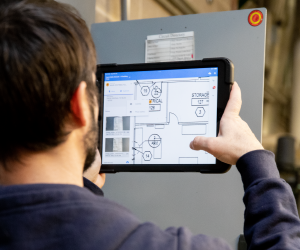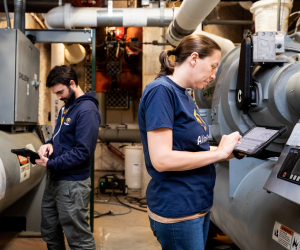
Presented by AkitaBox.
On the surface, day-to-day facility management and leadership discussions on capital planning appear to be worlds apart. But there’s one key component each end of that spectrum needs to do their job effectively: Facilities data. In particular, the run-of-the-mill information your assets and FM teams generate every day, such as:
- What assets do you have?
- Where are they located?
- What condition are they in?
- What’s their maintenance history? When and why was it last touched?
- What was the cost to install?
- What’s the cost to replace vs. repair?
- How far along is it in its expected lifespan?
If this basic data isn’t available, everyone from the boiler room to the boardroom is hard-pressed to make the best decisions for everything from keeping the lights on to long-term budgeting and investments.
Why make data and data management top priorities?
The old saying, “the devil is in the details” is never truer than when it comes to facilities data. At AkitaBox, we know just a few missing details can impact building occupants’ ability to do their jobs or budgetary committees’ confidence in allocating funds.
Collecting (and maintaining) facilities data – such as asset condition, maintenance logs, inspection results, energy efficiency and repair vs. replacement costs – gives you clear visibility into what’s happening in your buildings today and what you need to plan for tomorrow.
Let’s consider eight ways collecting and maintaining up-to-date facility data has organization-wide impact:
An always-current view of your facilities
Your facilities are constantly changing. Good data management provides a constant stream of real-time information on what’s going on in your facilities.
Easy access to asset information
Complete, organized asset data in one easy-to-navigate place enables maintenance staff and outside contractors to quickly find the necessary data to do their jobs. That makes them more efficient and able to respond to work orders faster.
Facilities data lives in a system, not people’s heads
There’s a wealth of knowledge in the brains of your most experienced team members.
But what if they leave or retire? There are hard and soft costs associated with losing that data.
More proactive (less reactive) asset management
Proactive, preventive asset management requires accurate facilities data. Knowing the assets you have and their current condition, maintenance history, estimated remaining lifespan, etc., gives insight to plan and schedule preventive maintenance.
Improved compliance and safety
With accurate, current data you can monitor your compliance and safety hazards and resolve issues before they become a problem.
More accurate capital planning and budgeting
Trustworthy facilities data provides tangible proof on where to assign priority to limited dollars towards upgrades, repairs or expansions in future budget cycles.
Wise resource allocation and maintenance deferrals
With data, you don’t have to guess whether you should repair or replace an asset.
Beyond just facilities management—facility optimization
Data lets you not only manage your facilities but optimize them. From reducing costs and risks to boosting productivity and energy efficiency, you’re able to monitor performance, identify areas to change and measure results of the improvements you make.
Whip your facilities data into shape
Even the best facilities people in the world struggle to maintain building and asset data without the proper tools.
Basic spreadsheets and databases just don’t cut it for managing sophisticated facilities information. To keep data alive, it needs to be in an environment designed to help you succeed—a facilities management technology platform. Here are three benefits of implementing an FM system.
1. Data interoperability and a single source of truth
Facilities data comes from multiple sources and lives in various silos. This makes it hard to find, track and consistently update. In an ideal world, all your data from assessments, audits, maintenance, inspections, work orders, etc., works together. A facilities management software platform provides a single spot for that data to come together for easier access and analysis.
2. The basis for a digital twin
A digital twin makes it easier to know where your assets are, what you’re maintaining and tracking and to find the asset data you need. Location-based facilities management software is step one to creating your own digital twin. It maps assets onto your floor plan in a digital environment where you can interact with your data and add information over time.
3. Easier data stewardship
Everyone with boots on the ground at your facility needs to be able to access and update asset data in real time. Choosing an FM software that lets your team and vendors collect data on mobile devices as they work is key to keeping asset information up to date.
The path to great data is great data collection
We’ve identified the major benefits of good facilities data. Of course, knowing you need dependable data is one thing – gathering it is something else entirely.
Time and expense are the biggest burdens of facility/asset data collection. Picking a data collection tool that reduces the strain on your budget and the teams who collect the data puts you one big step closer to operationalizing your data for FM and capital planning. The bottom line? You want to equip the right people at the right time with the right tools.
Let’s dive into the characteristics of a great data collection tool:
- Mobile: Ability to use it in the field with a mobile device.
- Fast: Includes Optical Character Recognition (OCR) technology that “reads” data within photos and adds it to the system, no typing required.
- Easy to learn and to use: Simply requires the ability to type and take photos.
- Customizable: Add or subtract data fields so you only collect what you need.
- Works offline: Lets you add data even while offline and then sync once you’re back online.
- Asset-level records: Every piece of data is tied to a specific asset for granular and high-level data transparency.
- Location-based: The assets you wish to track are pinned to a digital version of your floor plans.
- Actionable: The data you collect is interoperable with your facility management system for reporting, analysis and decision making.
This isn’t a utopian fantasy. Technology exists today that makes this possible. Everyone in the field can be empowered to update facilities data, keeping it alive, sustainable and actionable.
With this steady stream of fresh data coming from the field, you’re making decisions from real-time information, not five-year-old data.
If you’re tired of managing facilities without the advantages of current data, it’s time for a change. With tools like AkitaBox Capture and a partner like AkitaBox, you’ve got this. Contact us today to begin mapping out the future of your facilities data.


